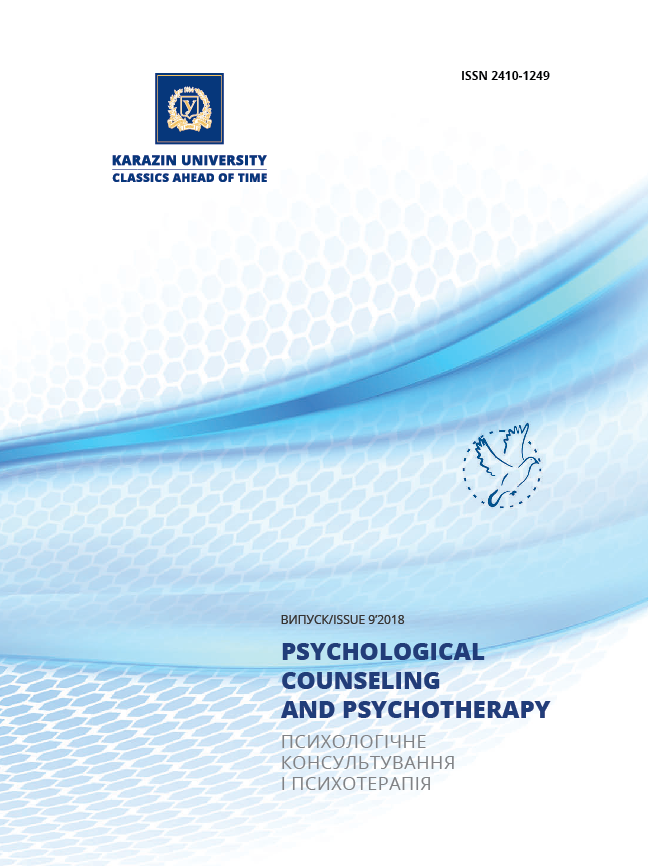FEATURES OF THE INTERCONNECTION BETWEEN SELF-ESTEEM AND BEHAVIORAL COMPONENT OF "I-CONCEPT" OF PERSONALITY WITH ANOMALY OF REFRACTION (ON THE EXAMPLE OF MYOPIA)
Abstract
Problem statement. In modern studies, the question of structural features of "I-concept" of adult person with anomaly of refraction remains relevant.
Problem analysis. In psychological literature, the topic of the interconnection between self-esteem and the behavioral component of "I-concept" of adult person with anomaly of refraction (on the example of myopia) is not covered enough.
The purpose of the study - to reveal the features of this interconnection.
Research methods. Testing: inquirer LSI (R. Plutchik, H. Kellerman & H. R. Conte), method of the quantitative evaluation of self-esteem (by S. A. Budassi), method of diagnostics of person's tendency to conflict behavior (K. Thomas, adaptation of N.V. Gryshyna), Taylor Manifest Anxiety Scale (adaptation of V. G. Norakidze). Statistical processing of testing data: f-criterion and factor analysis.
Description of the sample: 50 persons (31 women and 19 men), 25 - without visual impairment, and 25 - with myopia.
Research results. The anomaly of refraction (on the example of myopia) affects certain features of the behavioral component of "I-concept" of personality. Personality with myopia prefers the psychological defense mechanism "negation", when regulating conflicts, it often refers to "collaborating".
The study of the interconnections between the test indicators revealed a wider, varied and contradictory nature of these connections in the group of persons with myopia.
Conclusions. The nature of the interconnection between self-esteem and the behavioral component of "I-concept" of personality with anomaly of refraction (on the example of myopia) is determined by the following features.
The activation of the psychological defense mechanism "rationalization" contributes to increase of self-esteem, stimulates the mechanisms of "displacement" and "compensation", which has a certain influence on the choice of "collaborating" as the dominant conflict-handling mode. The above features are accompanied by a certain complication (contradiction) of the behavioral component of "I-concept".
The results obtained can be useful in conducting counseling work with people who have anomaly of refraction.
Downloads
References
Arkhireeva T. V. Системный подход к пониманию структуры Я-концепций и закономерностей ее развития в детском возрасте [A systematic approach to understanding the structure of the self-concept and the patterns of its development in childhood] // Kul'turno-istoricheskaya psikhologiya. – 2008. – no.4. – P. 48-55. (in Russian)
Berns R. Развитие Я-концепции и воспитание [The development of self-concept and education]. - M.: "Progress", 1986. – P. 30-66. (in Russian)
Dolgova V.I., Ordina I.P. Я-концепция одаренных старшеклассников [I-concept of gifted high school students: Monograph]. – Bishkek: Izd-vo «DETs», 2012. – 155 p. (in Russian)
Dorosheva E.A., Rippinen T.O. Формирование образа Я у старших подростков со школьной близорукостью [Formation of the image I have in older teens with school myopia] // Vestnik NGU. Seriya: Psikhologiya, 2007. – no.2. – P. 65-77. (in Russian)
Petukhov V.M., Medvedev A.V. Особенности возникновения и прогрессирования школьной близорукости в условиях современного учебного процесса и их профилактика [Features of the occurrence and progression of school myopia in the conditions of the modern educational process and their prevention]. – Samara: Samar. gos. med. Un t, 2005. – P. 35-40. (in Russian)
Cherepakhina M.A., Rybakova E.G., Gurevich K.G. Зависимость качества жизни пациентов с миопией от степеней миопии и средства коррекции зрения [Dependence of the quality of life of patients with myopia on the degree of myopia and means of vision correction] // Klinicheskaya oftal'mologiya. Vol. 13. – no.2. – 2012. – P. 70 74. (in Russian)








